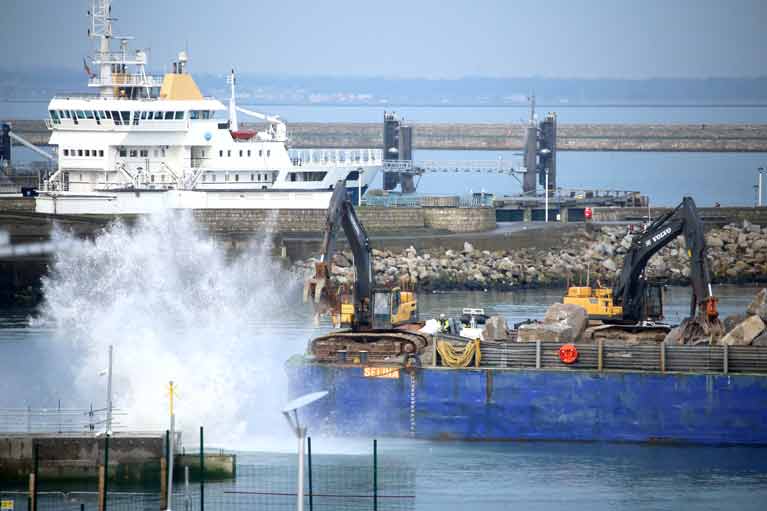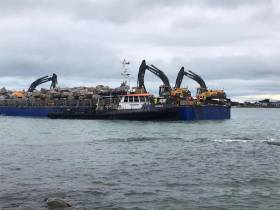Displaying items by tag: Rock Armour
Rock Armour Delivery Completed By Barge But Work Remains at Dun Laoghaire Baths Project
#dublinbay - Rock armour delivered for the Dun Laoghaire Baths redevelopment project, has been completed, though further work on the foreshore is underway to position boulders into place, writes Jehan Ashmore.
Around 4,300 tonnes of granite which was transported by barge from Falmouth, in the UK, is to be used to provide coastal protection from erosion at the site and associated newly built jetty on Scotsman's Bay.
Coastal works involved the barge Selina which self-discharged the rocks onto the foreshore, while under the assistance of tugs Husky and MTS Indus. Originally the delivery of rocks to the site along Newtownsmith was to have taken a fortnight, however weather conditions hampered such efforts.
 Making a splash - The Barge Selina deposits rock armour in Scotsman's Bay. Photo: Afloat.ie
Making a splash - The Barge Selina deposits rock armour in Scotsman's Bay. Photo: Afloat.ie
The final load of boulders was taken from Dun Laoghaire Harbour to the neighbouring bay and on Thursday, MTS Indus towed the barge back to the Cornish port.
The jetty jutting into Scotsman's Bay at the €10m baths project developed by Dún Laoghaire-Rathdown County Council, involves heavy machinery putting into place the rock armour by forming in layers. As for those lower and inner layers, they will be constructed using locally sourced granite of smaller rock sizes.
In total there is approximately 6,000 tonnes of rock armour being placed.
The public amenity will have changing areas that will provide access to the water's edge for swimmers and at the jetty, landing points for canoes, kayaks and other water sports equipment.
For further details click here on the overall project built by SIAC Construction which is due to be completed in Spring 2020.
Rocks at Dun Laoghaire Baths Redevelopment Take Shape
#DublinBay - The rock armour used at the site of the Dun Laoghaire Baths redevelopment project costing €10 million, can each weigh up to 6 tonnes, writes Jehan Ashmore.
Works on the coastal site between Dun Laoghaire Harbour's East Pier and Newtownsmith, began 10 days ago though since then bad weather has hampered in the dumping of the rocks.
Where times have been favourable, tugs have towed the 6,000 tonne barge, Selina, from the harbour around into Scotsmans Bay where a trio of grab excavators on board dump the rocks on to the foreshore. At this location is where the old baths site has lain derelict for more than two decades.
The boulders are then repositoned into place to act as rock armour so that the new jetty also for use by small craft in the baths project, will be protected from coastal erosion.
The public amenity is a project of Dun Laoghaire-Rathdown County Council, which is to transform the seafront and reinvent the area as a destination for swimmers and sports enthusiasts and draw visitors from far and wide to the borough.
In the meantime, such sea based operations of the project to install the rock armour, have involved the MTS Indus of UK based Marine & Towage Services Ltd of Brixham, Devon. In addition the services of Husky belonging to Wicklow Port based Alpha Marine which has been retained during the sea defence process.
MTS Indus is a single-screw multi-purpose tug with a bollard pull of 24 tonnes, that was also responsible in towing the Selina to Dun Laoghaire last month. On arrival to the harbour, the barge laden with rock armour from Falmouth, Cornwall, berthed at St. Michaels Pier, which has since acted as base in between works carried out subject to weather and tidal conditions.
When Selina has been towed outside the harbour by MTS Indus this is where Husky, a twin-screw, tug/workboat with advantage of a shallow draft has operated in close proximity of the foreshore (as shown in the photo above). The tug remains alongside the barge to hold into position to enable more accurate disposal of rocks grabbed by the excavators into the water.
The Belfast registered tug has undertaken many projects elsewhere, among them in the UK at Shoreham Harbour for a windfarm project of the Sussex coast as Alfoat reported last year.
As for the Irish project's additional facilities, they are to include a cafe and studio work spaces for artists. These features in the overall project that has been designed in house by DLRCoCo own architectural department.
The contract for the project from the council was awarded in a joint venture between SIAC Construction and Mantovani Group and is scheduled for completion in Spring 2020.

























































